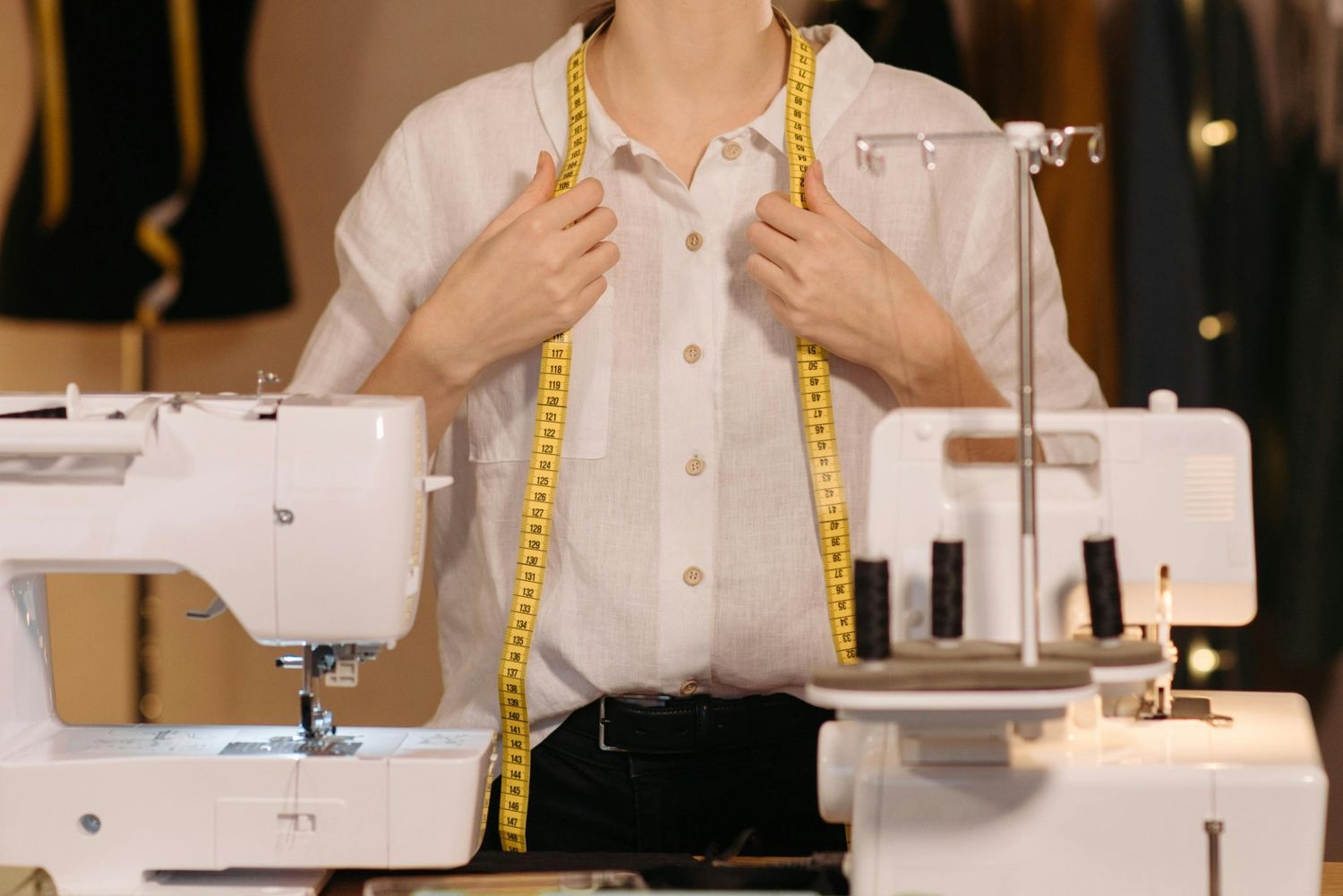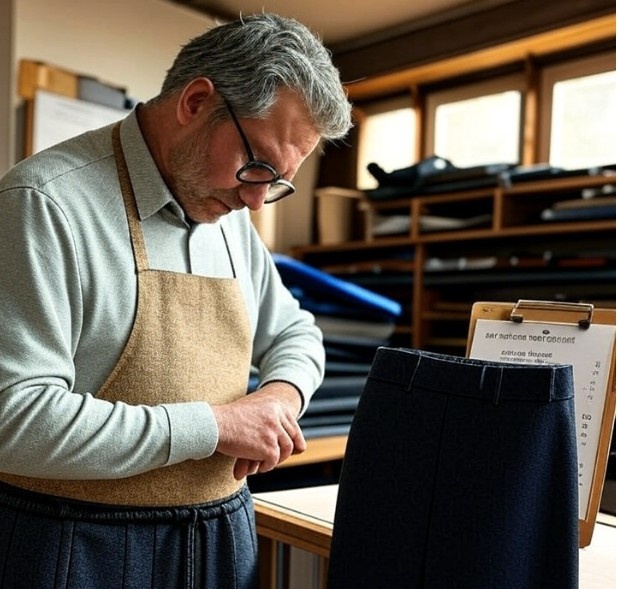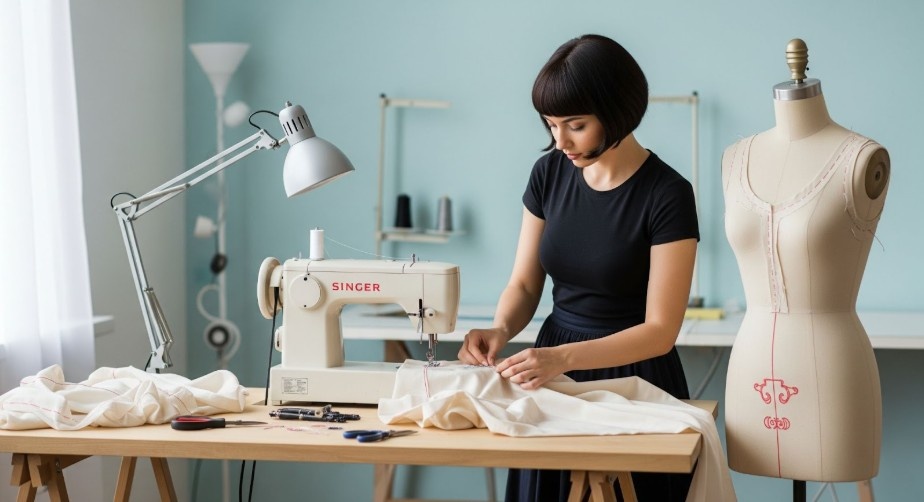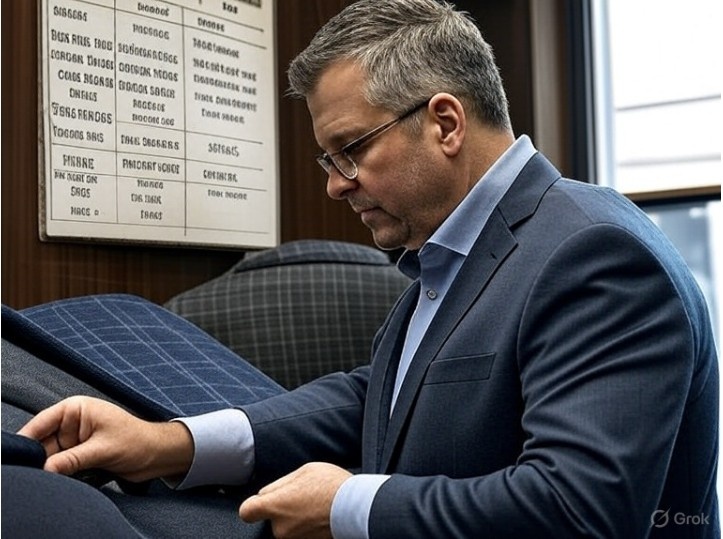
I still remember the first time I bought a dress that was just a little too big. It was the perfect shade of emerald green, silky, and elegant, but the fit? Not quite there.
It was hanging off me like a sack. So, I took a deep breath and ventured into the world of alterations. I had no idea what to expect—would it be an expensive investment?
How much do alterations cost? After all, I’d already splurged on the dress, and I wasn’t about to blow my budget on making it fit.
Turns out, I wasn’t alone in wondering about this! The cost of alterations can vary depending on the task, but the process is a game-changer when it comes to turning your wardrobe into something that truly fits your unique shape and style.
Whether you’re altering a dress for a wedding, hemming a pair of jeans, or adjusting a shirt, knowing what to expect in terms of cost is essential. Let’s break down the details and give you a roadmap for understanding how much you might spend on alterations.

Credit: Gemini
What Factors Affect the Cost of Alterations?
You’re probably wondering what drives the price of alterations. It turns out that there is a mix of factors that influence the final price.
The most important ones? The type of garment, the complexity of the work, and the location of the tailor or alteration shop. Let’s take a deeper dive.
1. The Type of Garment
A simple hem on a pair of jeans might cost you less than taking in the waist of a wedding dress or adjusting the length of a heavy winter coat.
The more fabric, the more time it takes, which naturally drives up the price. For example, hemming a basic pair of pants might cost anywhere from $10 to $20, but altering a dress could cost $50 or more, depending on the design and the level of detail.
2. The Complexity of the Work
Simple fixes like taking up hems, letting out seams, or shortening sleeves are usually on the cheaper end of the spectrum.
However, if you’re looking at a more complex alteration—like reshaping a bodice, adjusting a multi-layered skirt, or adding intricate beading to a gown—the cost can be much higher.
For instance, altering the fit of a jacket could cost anywhere from $20 to $60, while adding a hem to a floor-length gown might run you $70 or more.
3. Location of the Tailor
Where you go for alterations plays a huge role in pricing. In big cities, alterations are often more expensive due to higher rent and labor costs.
In contrast, smaller towns or less expensive areas may have more reasonable pricing. Expect to pay a premium in upscale neighborhoods or high-end boutiques, where highly skilled professionals do the work.
How Much Do Alterations Cost for Common Garments?
Now, let’s break it down by some common alterations and their average prices. Keep in mind that these prices can vary by region, but this will give you a general sense of what to expect.
Slacks / Trousers
| Service | Price |
|---|---|
| Plain Hem | $18 |
| Cuffed/Vented/Palazzo Hem | $24 |
| Faced Hem | $30 |
| Original Jean Hem | $30 |
| Blind Hem by Hand | $30 |
| Waist/Seat in or out | $22 |
| Separate Waistband | $30 |
| Jeans (unspecified) | $35 |
| Add Gusset (per) | $15 |
| Seat Only | $15 |
| Crotch/Stride Reshaping | $35 |
| Taper Legs < 3” | $30 |
| Taper Legs > 3” / Felled / Plaid | $40 |
| Stride & Taper Together | $50 |
| Lower Plain Waistband | $40 |
| Replace Plain Elastic | $25 |
| Replace Fly Zipper | $28 |
| Jeans Zipper | $35 |
| Replace Full Lining | $110+ |
| Replace Half Lining | $80+ |
| Add Belt Loops | $25 |
| Make & Add Loops | $40 |
Coats / Blazers
| Service | Price |
|---|---|
| Taper Sides or Back | $40 |
| Taper Through Blades | $75 |
| Double Vents (Add) | $15 |
| Raise / Lower Collar | $45 |
| Shorten Plain Hem | $40 |
| Shorten Plain Sleeves | $18 |
| Shorten Vented Sleeves | $30 |
| Stitched Buttonholes (Add) | $10 |
| Replace Zipper | $35+ |
| Zipper Guard/Topstitch (Add each) | $10 |
| Replace Pocket (each) | $15 |
| Replace Lining | $150+ |
| Taper Sleeves | $32 |
| Add Shoulder Pads | $15 |
| Remove/Replace Shoulder Pads | $10/$20 |
Blouses / Shirts
| Service | Price |
|---|---|
| Taper Sides | $25 |
| Felled/Vented Sides | $35 |
| Shorten/Hem Straight | $25 |
| Curved/Vented Hem | $30 |
| Shorten Plain Sleeves | $18 |
| Cuffed/Vented Sleeves | $25 |
| Add / Remove Darts | $25 |
| Take Up Shoulders (no sleeves/collar) | $22 |
| With Sleeves/Collar | $32+ |
| Add Bra Carriers | $16 |
Skirts / Dresses
| Service | Price |
|---|---|
| Straight Hem (< 45”) | $25 |
| A-Line or Vented Hem | $30 |
| Full or Pleated Hem (>70”) | $40 |
| Chiffon Hem (per layer) | $50 |
| Handkerchief Hem (per layer) | $60 |
| Hand Sewn Hem | x2 |
| Taper Sides | $32 |
| Lower Plain Waistband | $40 |
| Replace Zipper | $28 |
| Take Up Shoulders (no sleeves) | $22 |
| With Sleeves/Collar | $32+ |
| Tape Neckline | $30–$50 |
| Replace Lining (Skirt/Dress) | $65+ / $90+ |
Formal Dresses
| Service | Price |
|---|---|
| Shorten from Waist (front) | $100+ |
| Hem Scalloped Lace | $100+ |
| Hem with Horsehair (Add) | $25 |
| Add Gussets (plus fabric) | $50+ |
| Alter Lace Seam (per 6″) | $25 |
| Alter Beaded Seam | $25–$75 |
| Seams with Boning (Add) | $20 |
| Add Bra Cups | $20 |
| Convert to Corset Back | $100 |
| Steam/Press | $20–$90 |
Miscellaneous
| Service | Price |
|---|---|
| Machined Buttonhole | $10 (1st), $2/add |
| Re-sew Button/Snap/Hook | $1 each |
| Replace Button/Snap/Hook | $2 each |
| Heavy/Lined/Leather Garments | x2 |
| Decorative Patch < 5” (Off/On) | $2 / $3 |
| Larger Decorative Patches | $5+ |
| On Leather | $10+ |
| By Hand | $5 + $0.50/in |
| Mending, Patching & Repairs | $5–$8+ per area |
| By Hand Mending | $15+ |
| Replace Zipper Pull | $12 |
| Minimum Invoice | $10 |
Notes:
-
Add $10 per seam set if lined.
-
Additional charges may apply for topstitching or special detailing.
-
Baste fitting for involved alterations starts at $15+.
1. Hemming Pants or Jeans
One of the most common alterations people get done is hemming pants or jeans. This could cost anywhere from $10 to $20, depending on the fabric and the work involved. For example, a standard hem on a pair of cotton pants is usually on the lower end, while denim or thicker fabrics might be a bit pricier.
 Credit: Grok
Credit: Grok
2. Taking in or Letting Out a Dress or Shirt
If you bought a dress or shirt that doesn’t quite fit the way you want it to, taking it in (or letting it out) is a simple alteration.
Depending on the garment, this might range from $20 to $50. A dress, for example, might cost around $40 to adjust at the sides, while a shirt may cost $20 to $30.
3. Adjusting Sleeves on a Jacket or Shirt
Sleeve alterations are relatively straightforward, but they can still add up. Expect to pay anywhere from $15 to $40 for shortening or lengthening sleeves on a jacket or blouse.
The complexity of the jacket’s structure (like a suit jacket with lining) will influence the price.
4. Taking in a Waist or Fitting a Bodice
If a garment fits you well in some areas but is loose or too tight in others, adjusting the waist or bodice by taking it in or letting it out can significantly improve the fit.
This is typically a more detailed alteration, so the cost can range from $30 to $75 or more, depending on the garment. Wedding dresses, for instance, can cost $100 to $200 for intricate bodice work.
How to Make the Most of Your Alteration Budget
Getting your clothes altered is a great way to save money while making your wardrobe work for you, but there are a few ways to get the best value for your dollar. Here’s how to make the most of your alteration investment:
1. Prioritize High-Impact Items
Focus your alteration budget on the pieces that will have the biggest impact on your wardrobe. A tailor-made dress that fits perfectly can be worn again and again, whereas a cheap trendy piece might not be worth altering.
If you invest in key wardrobe pieces like jeans, blazers, or dresses, alterations can make them feel like they were custom-made just for you.

Credit: Gemini
2. Use Simple Fixes for Quick Updates
Sometimes, the smallest alteration can make a huge difference. For instance, getting the hem of your pants or sleeves shortened could make your entire outfit look more polished without costing much. Start with the simple fixes first to build a wardrobe of well-fitted, versatile pieces.
3. Find the Right Tailor
Don’t just go to the first alteration shop you find. Take the time to research and read reviews. Ask for recommendations from friends and family to ensure you find a tailor who is skilled and reasonably priced. A skilled tailor can help you maximize the value of your clothing while staying within your budget.
FAQ: Answering Your Alteration Questions
Can I alter clothes myself to save money?
If you’re handy with a sewing machine, altering your own clothes can be a great way to save money. For simple tasks like hemming or taking in seams, sewing your own alterations is entirely doable. However, for more complex tasks, such as tailoring suits or adjusting the fit of a dress, it’s often best to consult a professional to ensure the best outcome.
Do tailors charge differently for different fabrics?
Yes! The fabric of your garment can affect the cost of alterations. For example, delicate fabrics such as silk, velvet, or lace may be more expensive to alter than more durable fabrics like cotton or denim. The complexity of working with certain fabrics requires more skill and care, which adds to the price.
How long does it take to get an alteration done?
The time it takes to complete an alteration depends on the complexity of the work and the tailor’s workload. Simple alterations, such as hemming or adjusting a shirt, can be completed in just a few days. However, more intricate work, like altering a wedding dress or custom-tailoring a jacket, could take a week or more.
Can I negotiate alteration prices with my tailor?
It’s always a good idea to discuss the cost upfront with your tailor. While prices are often set, especially for complex jobs, some tailors may be open to negotiation, particularly if you’re bringing in multiple items or have a long-term relationship with them. Just be polite and transparent about your budget.
 Credit: Grok
Credit: Grok
Final Scoop Before You Jump In
When it comes to the cost of alterations, there’s no one-size-fits-all answer. The final price depends on the garment, the work needed, and where you’re getting it done. However, with a little bit of research and careful consideration, you can make alterations work for you—creating a wardrobe full of custom-fitted pieces that make you feel amazing.
Whether you’re tweaking your favorite pair of jeans or transforming a thrifted dress into something more fabulous, alterations are a sustainable and cost-effective way to keep your wardrobe fresh. The key is to prioritize the pieces that will make the most impact on your style, and to find a skilled tailor who can bring your vision to life—without breaking the bank! Happy sewing and shopping!



